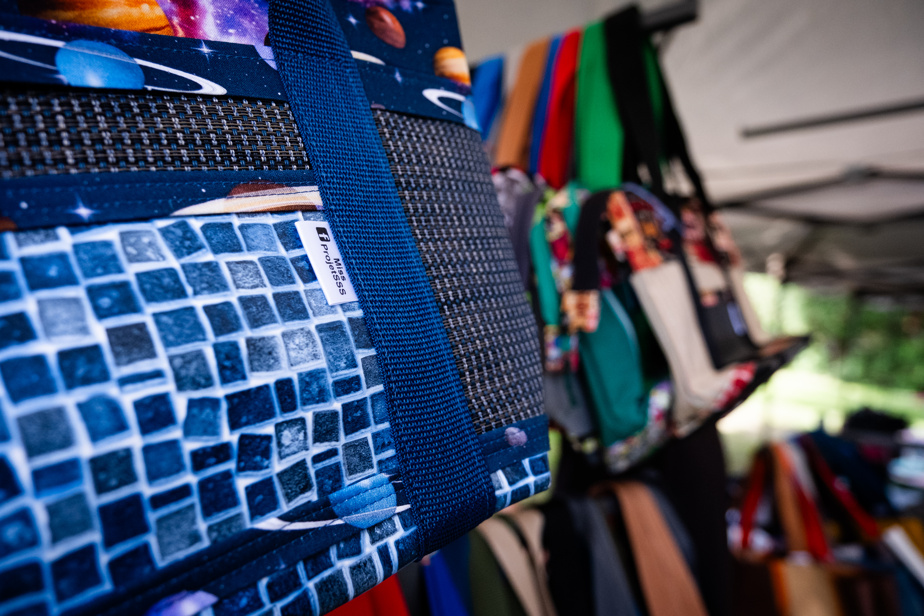Thanks to a retired couple from the City of Montreal, the bottom of a swimming pool can completely change its purpose. The same goes for the folding lawn chairs from the 1960s and 1970s, with the orange and brown stripes. They sometimes become lunch boxes, sometimes bags, cosmetic bags or cases, of all kinds.
Josée Bolduc, formerly a white-collar worker at the Montreal Botanical Garden, and Serge Gauthier, a retired inspector, transform new pool covers destined for waste, awning covers, folding chair covers, spa vinyl and marquee vinyl. Even hospital mattress covers. Without really realizing it at first, they have become specialists in the circular economy.

PHOTO CHARLES WILLIAM PELLETIER, SPECIAL COLLABORATION
Josée Bolduc and Serge Gauthier, co-founders of MissProjetSSS
The couple founded a small craft business in their home in L’Assomption, in Lanaudière.
At first, it was just a hobby. Then, a passion. Today, it has become an unplanned second career, with the joy of participating in sustainable development, explains Mme Bolduc. The couple made an appointment at The Press at the opening of a street fair in the Sainte-Rose district of Laval. On portable clothing racks, he hung a good hundred creations from his company, called MissProjetSSS.
Each creation is unique. “No two are ever the same,” says M.me Bolduc. There’s the large tote bag available in every texture imaginable, the beach bag, and the two-in-one lunch box with its insulated bag. Everything is made from reclaimed textiles, with the exception of some cotton trims and zippers.

PHOTO CHARLES WILLIAM PELLETIER, SPECIAL COLLABORATION
Each of MissProjetSSS’s creations is unique.
“I have always had a manual side. At first, it was for fun, to occupy my retirement. I started with a small beach bag with new materials. I went to show it to my husband who, himself, has a natural talent for color matching, design. Then, quietly, the idea of using checked garden chair fabric appeared,” relates M.me Bolduc, by revealing a prototype designed with a sample of pebble-patterned pool bottom.
Mr. Gauthier says the idea of transforming swimming pool liners came to them when they went to have the water in their own swimming pool tested. His wife had just acquired an industrial sewing machine.
At first, the managers of the swimming pools looked at me strangely. It was not easy to convince them.
Serge Gauthier, co-founder of MissProjetSSS
Somehow, the new entrepreneur managed to glean canvas samples here and there. Until he met Sonia Leblanc, owner of Piscines Rive-Nord.
“I found their creations fun and inspiring,” she says. “We often have samples, surpluses that, for all sorts of reasons, are returned. I contacted people I know in the pool sales industry. I sold their bags in my business, and we started to supply them. In any case, the surpluses go to the waste sorting center,” she explains.
After meeting the pool center owner, the couple’s car trunk was full to bursting with canvas samples. Encouraged, Josée and Serge found some leftover insulation material for lunch boxes from a hospital mattress cover supplier. They started scavenging mica sheets from carport windows, new vinyl from spa covers, vinyl from event marquees, even barbecue covers.

PHOTO CHARLES WILLIAM PELLETIER, SPECIAL COLLABORATION
MissProjetSSS creations range in price from $20 to $50.
“The spa covers were still in their boxes. One day, I hit the jackpot, as they say. About fifty rolls of awning fabrics dating from the 1980s. Each lot weighs between 50 and 100 pounds. They were new, destined for the trash. We made a line of bags with these awnings,” says Mr. Gauthier.
Despite the hours required to make them (two to four hours depending on the complexity of the bag), their prices range from $20 to $50. The two entrepreneurs are in talks with a group of merchants to recover fabric. On occasion, they contribute to causes. In particular, they helped the Gisèle Faubert Foundation, dedicated to palliative care, by giving it $5 for each bag sold. Their goal is not to expand, but to continue creating, while contributing to the circular economy, they agree.
“We want to remain on a human scale,” says Mr. Gauthier.
Learn more
-
- 7.2%
- Globally, only 7.2% of resources are returned to the economy once they have been used, according to the Circularity Gap Report 2023. In Quebec, the circularity rate of the economy is more or less 3.5%, including construction materials. In the textile industry, initiatives remain rare.
